
In the modern work environment, things may not be as they appear. Behind the daily grind, there’s a hidden reality – workplace bullying. Beyond the usual tasks and meetings, this repetitive mistreatment, emotional strain, and toxic behavior quietly corrode both well-being and productivity. Let’s dig into the issue of workplace bullying and uncover its impact in today’s professional world. In this article, we dig into the data published by the Workplace Bullying Institute to determine how prevalent workplace bullying is, who it affects, and then offer a 3 step plan for how to handle any workplace bullying that you are experiencing.

The Workplace Bullying Institute (WBI) was started in 1997 and has been at the forefront of battling abusive conduct in workplaces. With the mission of prevention and rectification of such behavior, their approach involves educating targets and the public, training professionals, devising practical solutions for organizations and unions, conducting research, and advocating for new laws.
As a part of their mission, WBI defines workplace bullying as:
Workplace bullying can take various forms, ranging from subtle undermining to overt intimidation. The characteristics outlined above provide a primary framework for recognizing bullying behavior, enabling individuals to identify and address it effectively.
Recognizing the insidious nature of workplace bullying requires understanding its defining traits. The following characteristics shed light on its dynamics:
Driven by perpetrator’s Need for Control the individual(s).
Initiated with tactics and calculated precision, choosing timing, location, and methods of harassment.
Not confined to isolated incidents; it thrives on repetition and escalation.
Often undermine business Interests of bullies, as their personal agendas and power dynamics overshadow the actual work.
Resemblance to domestic violence, where an abusive spouse is on the payroll.
With these characteristics in mind, let’s delve into the statistical data that unveils the extent and impact of workplace bullying.
The WBI took the lead in conducting the surveys and partnered with Zogby International to gather data for two comprehensive studies focused on workplace bullying among adult Americans. The inaugural national study, which was initiated in 2007, laid the foundation for subsequent explorations. This article delves into a trilogy of surveys carried out in 2010, 2014, and 2017.
In conducting this survey, WBI took the initial step of establishing a precise definition of workplace bullying, perfectly mirroring the one outlined in the Healthy Workplace Bill. And, WBI asked Americans to consider solely on the most serious forms of bullying.
Then, WBI posed the following question: At work, what has been your personal experience with the following types of repeated mistreatment: abusive conduct that is threatening, intimidating, humiliating, work sabotage or verbal abuse?
In the 2010 survey, WBI categorized the group into two distinct and mutually exclusive segments: (1) those who experienced bullying within the last year or presently, and (2) those who had been bullied at some point in the past but not currently. And, the result showed that 35% of workers reported firsthand encounters with bullying.
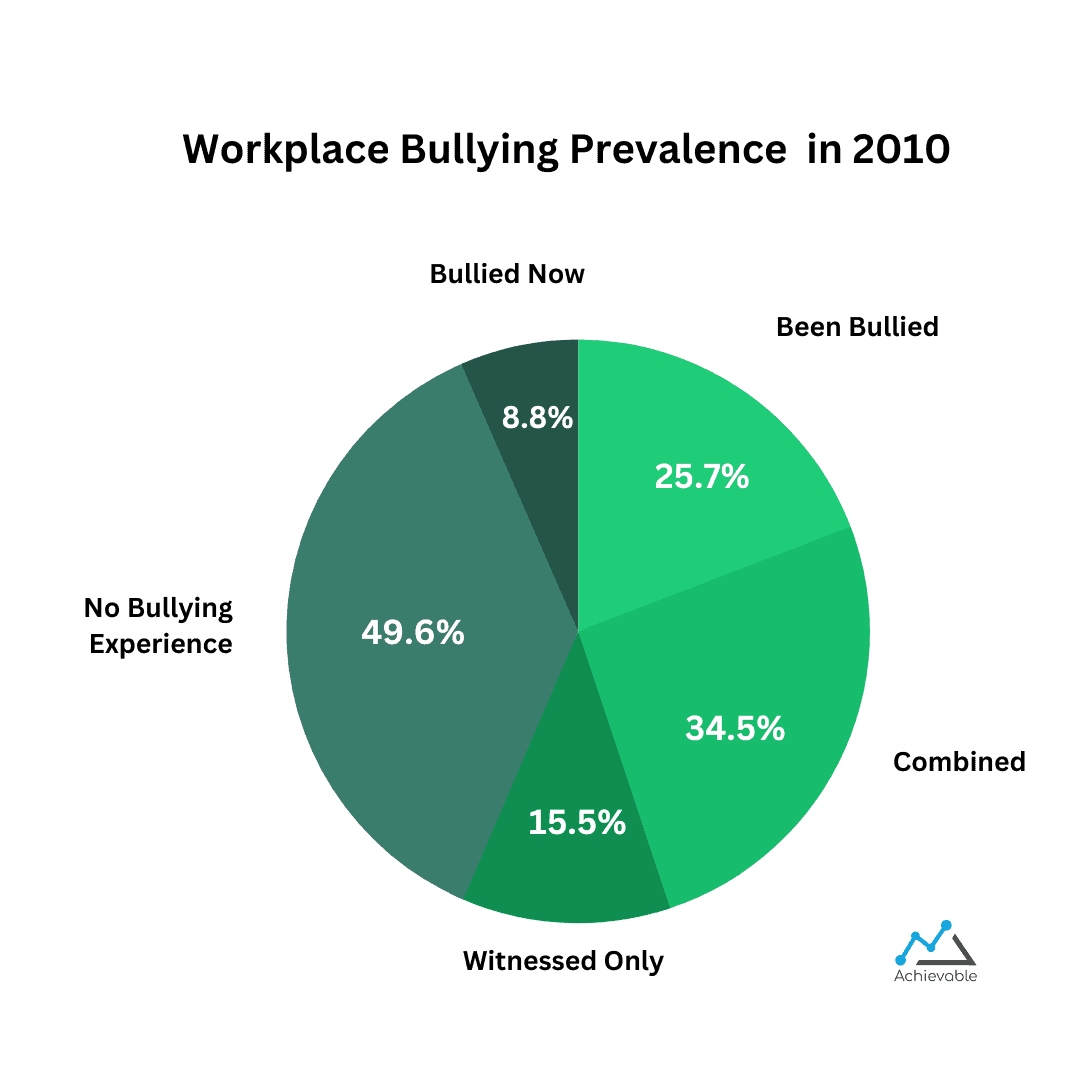
For the 2014 and 2017 surveys, WBI introduced a more detailed division within the group by transforming the previously singular answer “I have not experienced or witnessed it” into three distinct alternatives. Respondents were now prompted to indicate if they were aware of the occurrence of bullying, even if they hadn’t personally experienced it.
The 2014 survey indicated that 27% have current or past direct experience with abusive conduct at work, and 72% of the American public are aware of workplace bullying. This shows that workplace bullying is no secret, but it still happens to too many people.

Result in 2017 stated that 19% of Americans are bullied, another 19% witness it, and 63% of Americans are aware of abusive conduct in the workplace.
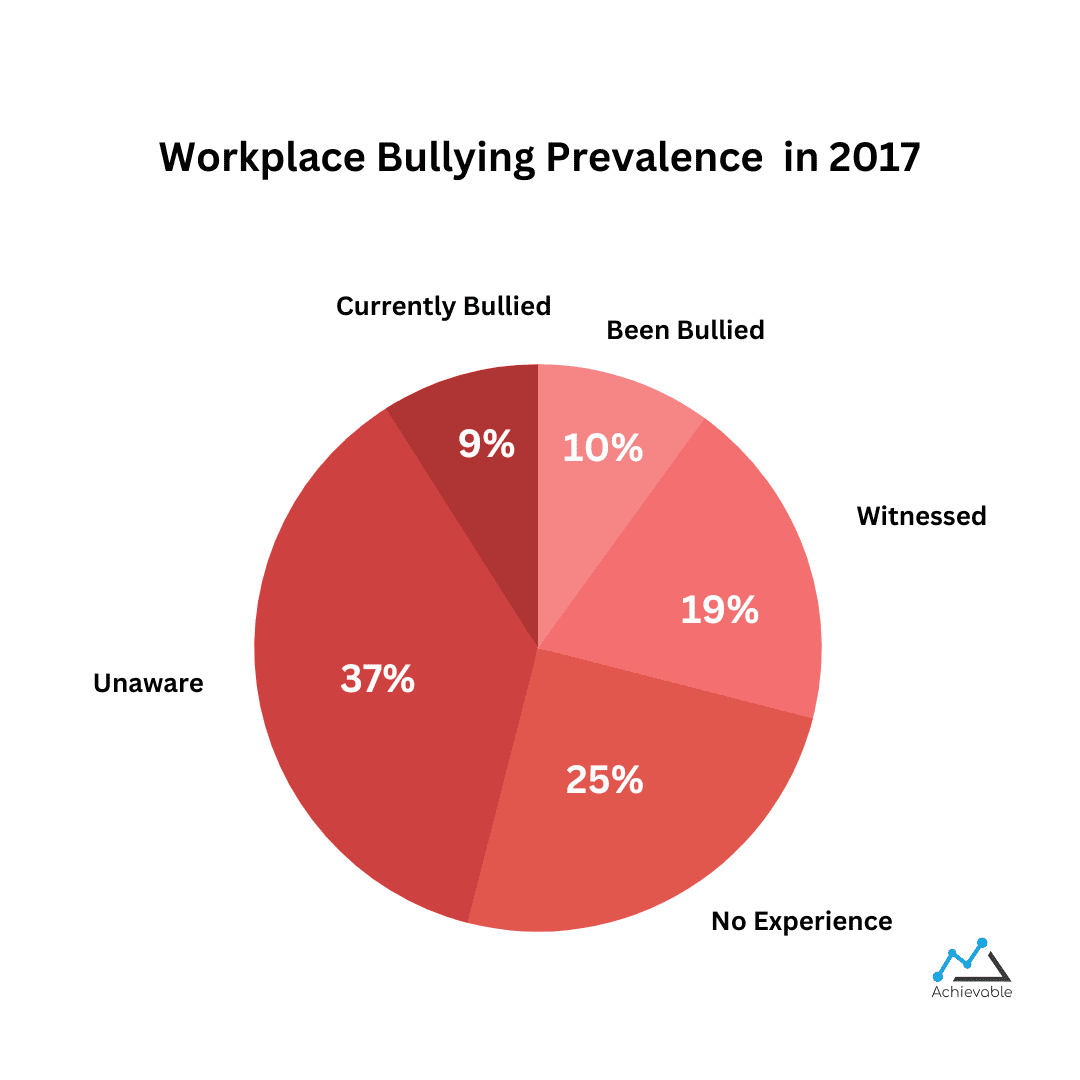
From these statistics, the good news is that there has been a gradual decline in the proportion of workers reporting firsthand bullying experiences. This is a decrease, which is good, but still too high for people who have suffered at the hands of a workplace bully.
Regardless of whether the occurrence of workplace bullying diminishes, the enduring effects remain profoundly significant. WBI claimed clearly that “bullying is the dominant psychosocial stressor in the work environment of targeted workers. That stressor triggers the human stress response. In turn, with prolonged exposure to frequent incidents, targets risk the onset of stress-related diseases. In other words, bullying is an occupational health hazard” (2017 survey).
In 2017, the survey asked the following question: Was the health of the targeted person adversely affected by the mistreatment?

The results notably indicated that 40% of targeted individuals are believed to experience adverse health effects due to bullying, while 60% express doubts regarding the harm caused. WBI expected that several factors contribute to this 60% of uncertain responses. Targets often refrain from sharing health issues with colleagues due to personal shame, suppressing open communication. Additionally, some targets may endure prolonged bullying without immediately recognizing its impact on their health, leading to delayed causal connections. This delayed recognition could account for target respondents falling within the 60% of doubters.
Both male and female perpetrators tend to target women as victims of bullying
Workplace Bullying Institute, 2017
WBI inquired about the gender of both the bullies and the targets in workplace situations, posing the question: Think of the perpetrator and target of repeated abusive mistreatment at work. What was the gender of each?
In 2014, it was notable that the majority of bullies are men, which is 69% of the whole cases. Interestingly, both male and female perpetrators exhibited a tendency to select women as targets for bullying. Specifically, women directed their mistreatment toward fellow women in 68% of instances and toward men in 57% of cases. Overall, women were the targets in 60% of reported cases.

The 2017 survey revealed similarities to the 2014 findings. Male individuals continued to dominate as bullies, accounting for 70% of cases, with women comprising the remaining 30%. Moreover, women remained the target in 66% of the reported cases.
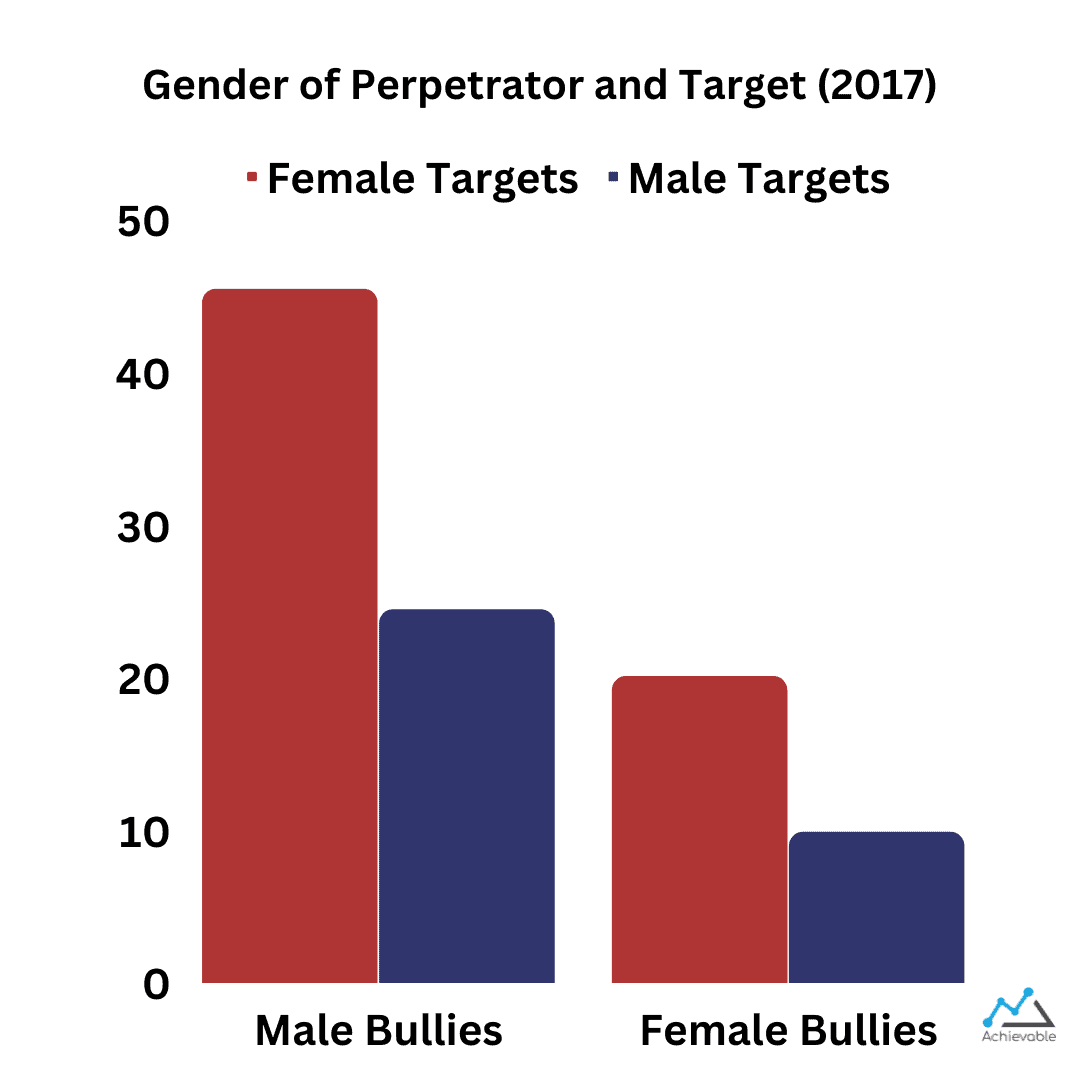
As you can see, both male and female bullies target females more often, adding to the pressures that women face in the workplace.
Hispanic and African American targets are bullied at higher rates than the national rate
Workplace Bullying Institute, 2014
Race is a crucial demographic variable used by pollsters to ensure a representative national sample in our U.S. WBI categorized each ethnic group based on their experiences with workplace bullying, including whether they were direct targets, witnesses, or affected in some way.
The 2014 survey revealed that nearly half (47.7%) of the respondents were affected by workplace bullying. Among the non-White groups, Hispanics had the highest rate, followed by African-Americans, both surpassing the U.S. average.
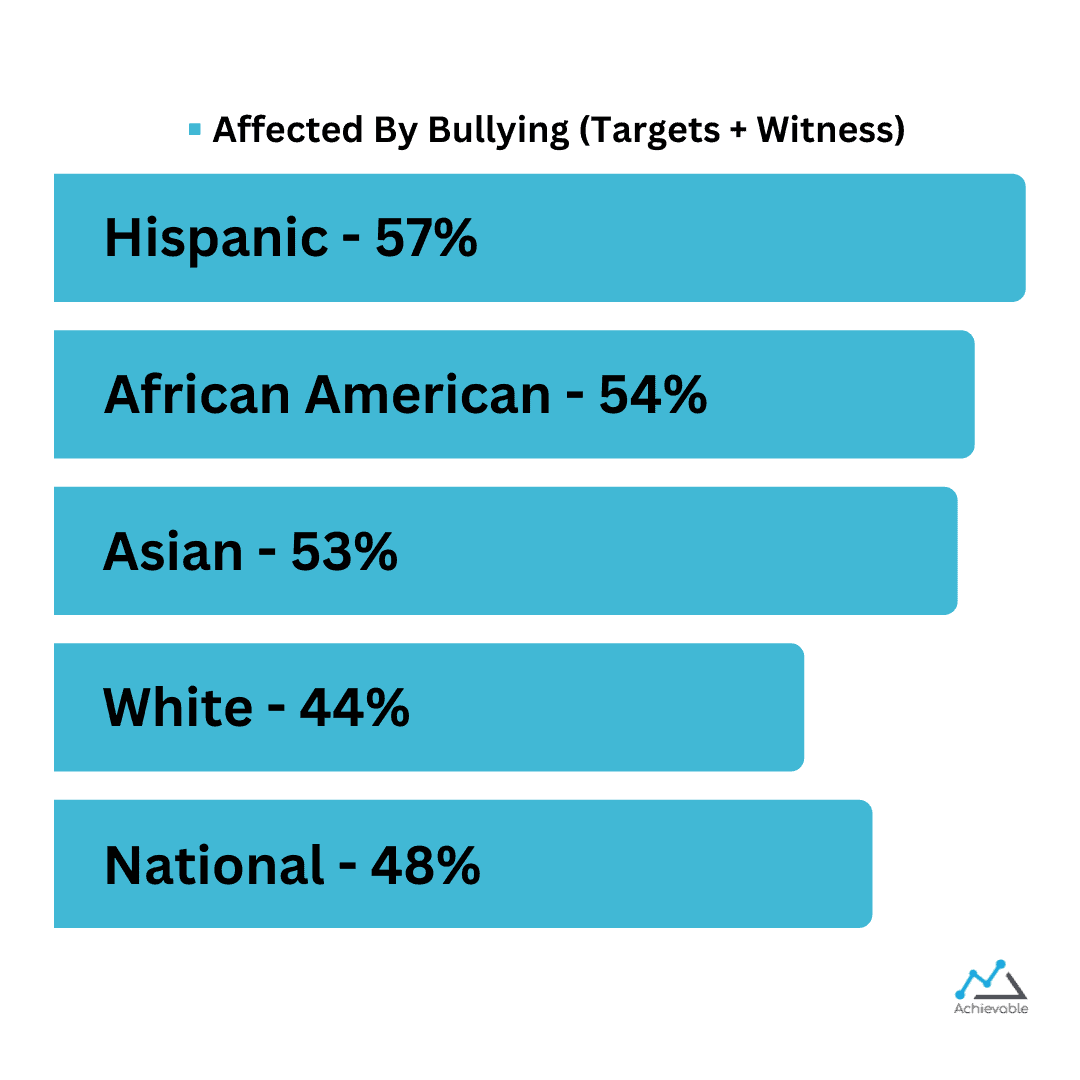
Similarly, the 2017 survey yielded comparable findings. The most targeted groups were Hispanics, followed by African-Americans and Whites. However, WBI indicated that only a limited number of self-identified Asian-Americans (30 in total) were part of the sample. It can be deduced from this small group that they were more inclined to witness bullying rather than consider themselves victims.
Race | Direct | Witness | Affected |
|---|---|---|---|
African American | 21% | 22% | 43% |
Asian | 7% | 44% | 51% |
Hispanic | 25% | 14% | 39% |
White | 19% | 17% | 36% |
National Sample | 19% | 19% | 37% |
Data: WBI Survey 2017 | |||
Over half of workplace bullies are bosses, and they usually operate alone
Workplace Bullying Institute, 2017
WBI referenced Heinz Leymann to define the term “mobbing,” describing it as “health-harming abusive conduct at work… [involving] multiple perpetrators, a gang” (2017 survey).
WBI asked the question: Who was (were) the principal perpetrator(s)?
The findings from the 2014 and 2017 surveys reveal consistent statistics. In 2014, the survey indicated that 77% of cases had single perpetrators, with 56% holding higher positions, such as bosses or top-down roles.

Also, the 2017 survey revealed that 63% of cases had single perpetrators, with 61% of these perpetrators holding a higher rank than their targets.

About this result, WBI indicated that “when perpetrators enjoy a higher organizational rank than targets, opportunities to abuse authority present themselves. Further, the likelihood of targets being able to confront the boss about her or his unacceptable conduct approaches zero, given the difficulty of crossing the “power gradient.” (2014 survey). Moreover, coworker-to-coworker bullying might not come with power imbalances, but the harm caused by social exclusion or ostracism employed by peers poses a similar problem.
Despite a decline in workplace bullying over time, as indicated by the aforementioned results, a significant portion of individuals still report being targeted for bullying. However, the act of reporting such mistreatment remains challenging for various reasons.
2017 survey asked who, if anyone, targets told about their experience, asking: To what extent did the targeted person make the mistreatment known?
Response choices | Percentage |
|---|---|
Told no one outside work | 12% |
Did not tell any employer representative | 17% |
Silent Target | 29% |
Told only coworkers | 36% |
Only informally notified employer | 18% |
Target informally reported experiences | 53% |
Filed a formal complaint with employer | 13% |
Filed a formal complaint with government agency | 3% |
Filed a lawsuit | 2% |
Target formally reported experiences | 18% |
Data: WBI Survey 2017 | |
Notably, the 2017 survey findings reveal that 29% of targets opt to remain silent about their experiences of abusive conduct, and merely 17% actively seek formal resolution.
This intriguing data highlights the persistent issue of workplace bullying, coupled with the reluctance or difficulties in addressing it. WBI states that “Without overt sharing of the bullying incidents and the impact of those incidents, the organizational culture that fostered bullying remains unchanged. Perpetrators rely on silence to act with impunity” (2017 survey).
While targets remain silent about their abusive conduct, the actions taken by employers to address it are minimal. In fact, employers often respond to reports of abusive conduct in ways that can further harm targets, such as condoning or explicitly sustaining bullying.
In the surveys, WBI asked the question: What do you know to be the most common American employer reaction to complaints of abusive conduct (when it is not illegal discrimination)?
The 2014 survey revealed that a significant portion, 72%, of American employers reacted by either denying, discounting, rationalizing, or even encouraging workplace bullying, while less than 20% took actions to address and prevent it.
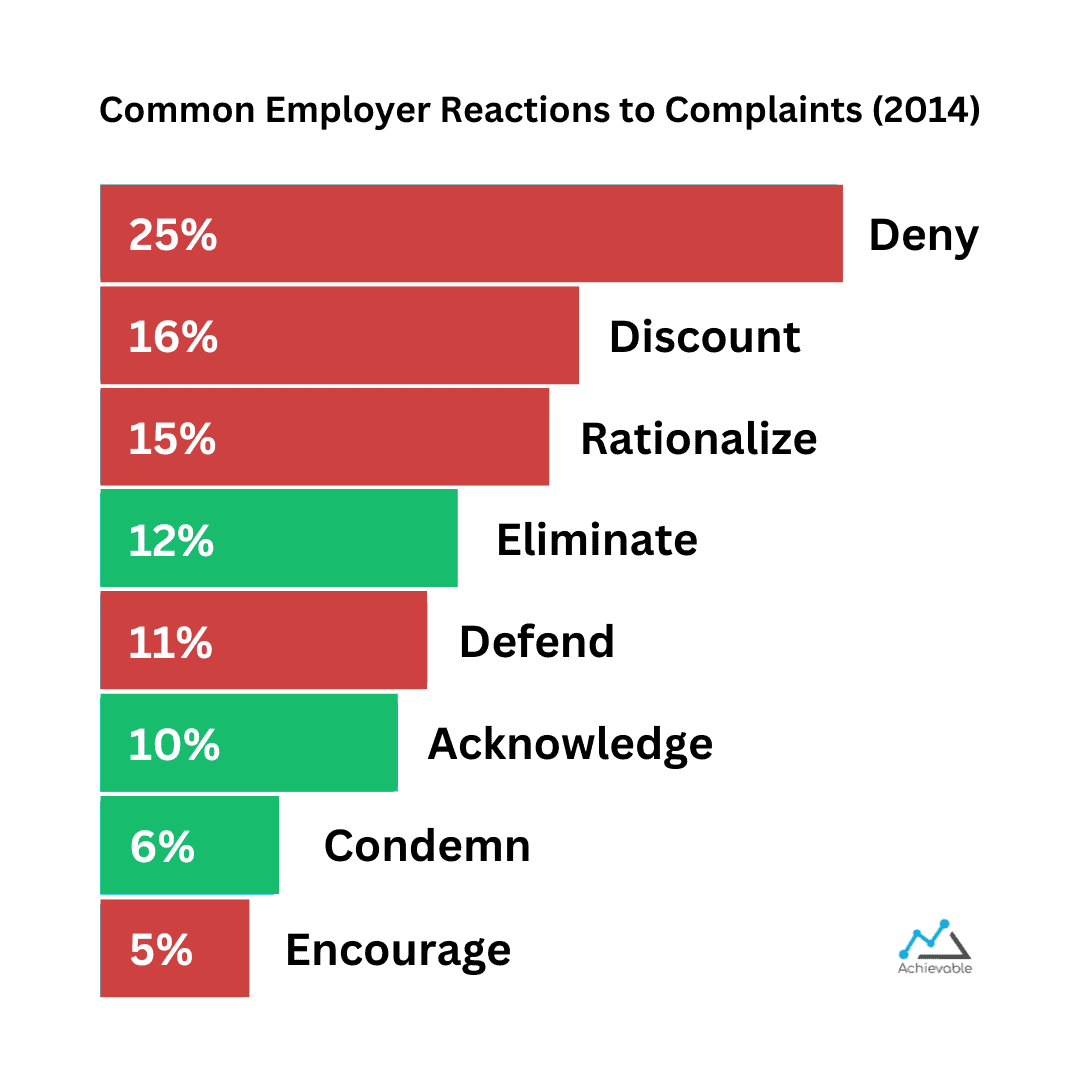
Also, in 2017, the survey even indicated that, of those respondents who were confident in their observations, the remaining 44% of the sample found that 71% of employers took actions that didn’t support the targeted workers, they actually harmed them. WBI says that “ the most frequent negative employer reaction is to conduct what targets describe as “sham” investigations characterized by major shortcoming” (2017 survey).
The survey also showed similar reactions for coworkers/witnesses, being doing nothing, ostracism, and siding with the bully.
WBI asked the question: How did most of the witnesses react to the repeated mistreatment of their targeted coworker?
In both 2014 and 2017, doing nothing was the most cited tactic. Positive witness reactions were in 40% of cases, according to survey respondents in 2017, where Negative actions were taken in 60% of cases.
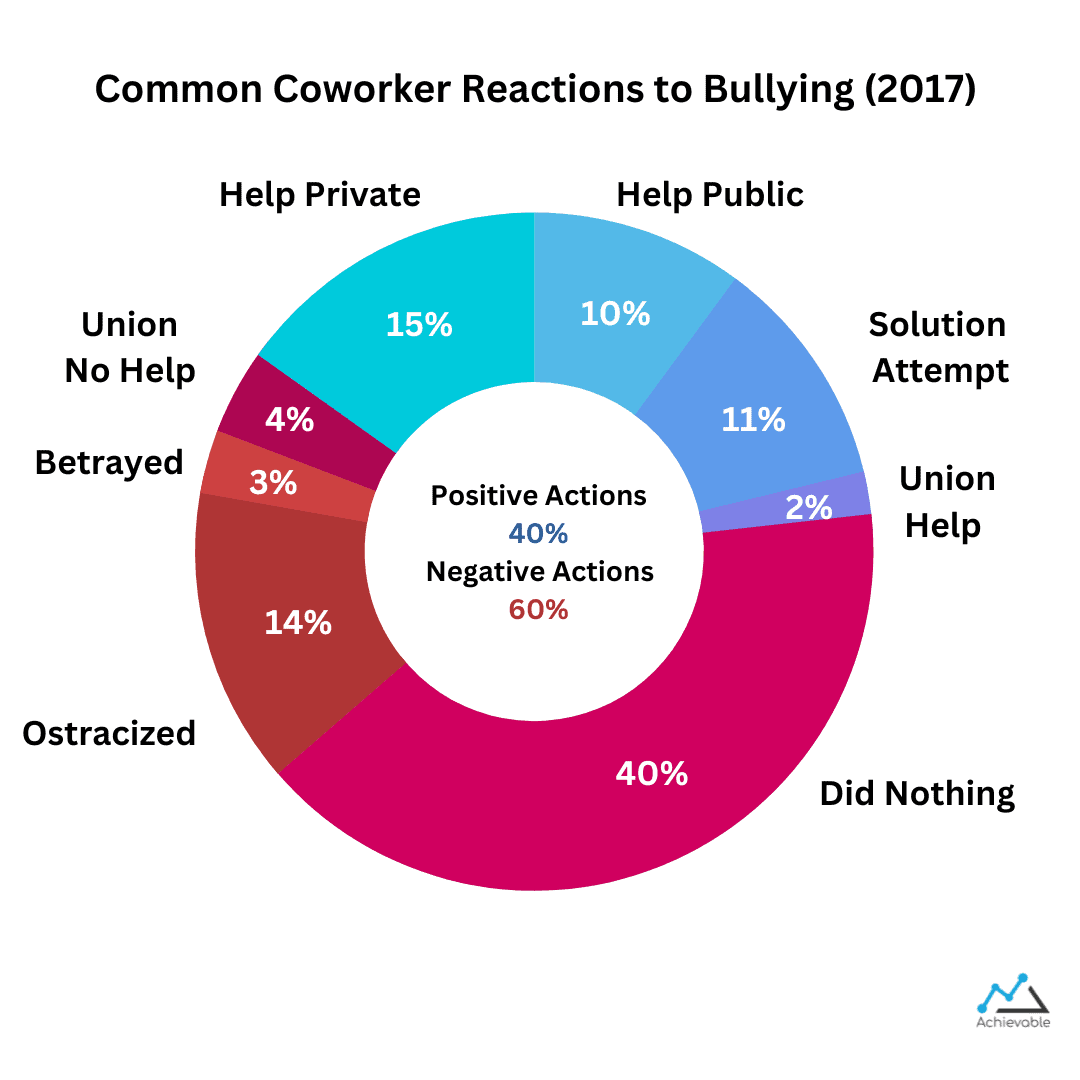
Then, WBI asked, “what stopped the abusive mistreatment?”
This question explores how much each player contributes to stopping the bullying and through which personal consequences. The survey included a response option “It has not stopped,” which was chosen by 18% in 2014 and 25% in 2017 of respondents.
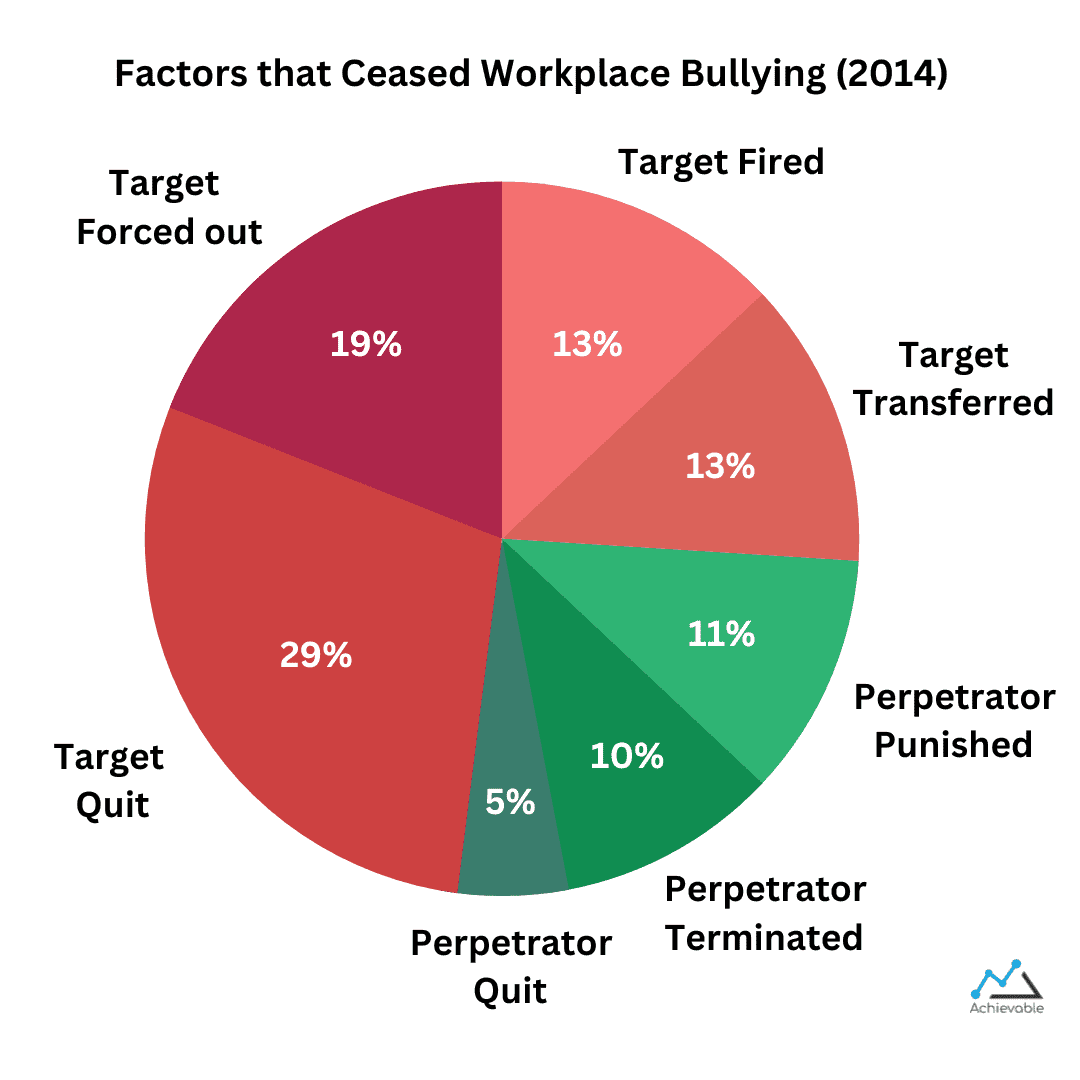
Sadly, it’s evident that even the general public recognizes that the burden of stopping bullying often falls on the victim. According to the 2014 survey, in 61% of cases, bullying only ceases when the target loses their job. It seems noticeable that individuals don’t willingly invite such severe hardships into their work lives. Consequently, once someone becomes a target of bullying, they face a 6 out of 10 chance of losing their job.
Additionally, this pressure often pushes the target to quit. Many leave due to worsening health problems, advised by family and doctors. Also, 40% resign when work becomes too unbearable, forcing them to seek an escape. This aligns with what many bullies want. According to WBI, terminations also happen, usually based on lies, especially for skilled employees or those seen as threats by bullies.
A significant majority (64%) of Americans support a law against workplace bullying
Workplace Bullying Institute, 2010
About Healthy Workplace Bill (HWB), which was a proposed national workplace bullying law, WBI conducted the national scientific survey in 2010, asking “Do you support or oppose enactment of workplace bullying laws that would protect all workers form what can be considered malicious, health-harming abusive conduct committed by bosses and co-workers?”
The results showed that support stands at 64%, opposition at 24%, with 12% expressing no opinion. Notably, support is 2.5 times higher than opposition.
Similarly, the survey in 2014 and 2017 asked “Do you support or oppose enactment of a new law that would protect all workers from repeated abusive mistreatment in addition to protections against illegal discrimination and harassment?”.
Clearly, the respondents for the 2014 survey, representing the informed American public, are keen to see enhanced worker protections that extend beyond mere anti-discrimination measures. A significant 93% express their backing for specialized anti-bullying laws like the Healthy Workplace Bill.
Response choices | Percentage |
|---|---|
Strongly support | 63% |
Somewhat support | 30% |
Somewhat oppose | 6% |
Strongly oppose | 1% |
Data: WBI Survey 2014 | |
Moreover, a noteworthy 50% of survey participants who identified themselves as Conservatives show robust support for the Healthy Workplace Bill. Given the limited opposition from the anticipated dissenters, it is evident that the moment is ripe for the enactment of this crucial legislation.
Strongly support | Somewhat support | Overall support | Oppose | |
|---|---|---|---|---|
Liberal | 74.3% | 22.9% | 97.2% | 2.8% |
Moderate | 68.8% | 27.6% | 96.4% | 3.6% |
Conservative | 49.5% | 36.2% | 86.2% | 13.8% |
Data: WBI Survey 2017 | ||||
In 2014, the Healthy Workplace Bill, aimed at tackling abusive behavior in American workplaces, was proposed in 26 states (at the time of this Survey). Yet it had not been ratified as law, despite the growing sentiment among the public aware of bullying that the time was ripe for change. During the collection of the 2017 WBI U.S. Workplace Bullying data, the HWB had made its way into discussions in 30 states and Territories, but its full enforcement as law was still a work in progress.

Due to many difficulties, addressing workplace bullying requires a strategic and proactive strategy. So, WBI developed the following three-step action plan that provides a holistic approach to empower those encountering bullying and facilitate impactful transformations in the workplace setting.
Pick a term, such as bullying, psychological harassment, psychological violence, or emotional abuse. This can not only counter the idea that your issue isn’t a legal problem, but also help combat the sense of invalidation that often leads to self-blame and anxiety.
Begin by seeking a professional assessment of your mental and physical well-being, avoiding the employer’s EAP. Once you feel emotionally and physically stable and can make a clear decision, proceed to explore internal policies and potential federal legal remedies. Consulting an attorney is also advisable during this process. It is also good to start searching for the next job position.
According to WBI, being targeted initially holds the greatest risk, leading to job loss for 77.7% of targets. Dislodging the bully doesn’t increase this risk, as retaliation is likely. So unfortunately, in order to do this, you will need to plan your exit strategy ahead. Ethical employers remove bullies, while many promote them.
Build a strong case that the bully is costly to keep. Share data from Step 2 with a high-ranking person beyond HR, showing the impact. If this isn’t feasible in small businesses, consider leaving. Also, make sure you stay focused. Emotional tales of bullying may discount your credibility. Give the employer one chance. If they side with the bully, leave for your health. Some employers want to remove bullies; your insights help.
How you leave – exposing the issue or leaving quietly – affects your recovery and future. Share your experience openly; there’s no shame. You were just doing your job.
Critics often claim that our 3-Step Method could lead to termination, and they’re right in many cases. It’s crucial, though, for you to understand our rationale. WBI’s approach achieves four key objectives:
Goal 1: Prioritizing your personal health
Check if stress-related health problems have emerged and work to mitigate their effects. Prioritize your well-being by seeking medical advice and requesting stress-related blood tests. Consider consulting a skilled therapist to rebuild your self-esteem.
Goal 2: Having a proactive approach
The data-collection task (Step 2, Part 4) helps shift focus from emotional pain, which can leave victims feeling stuck. Estimate the financial cost of bullying – often overlooked by organizations – to reveal facts about the irrationality of the process. Keep in mind, it’s not your fault; their inaction is fueled by fear.
Goal 3: Recognizing its accountability
Urge employers to recognize their contribution to your harm. You’re not at fault for attracting bullying. Employers knowingly retain bullies under negligent retention. They might term it “personality clashes,” but they shape the work atmosphere. Hold them responsible, uncover the bully, and call for organizational change.
Goal 4: Regaining control as you leave
Studies show a 66% risk of job loss when targeted. Exposing the bully aids your well-being, not just their removal. If you leave, do so with dignity, holding them accountable. Silence only adds shame; an open exit often speeds recovery.
Actions to avoid when dealing with workplace bullying:
If you find yourself facing workplace bullying, it’s important to remember that you are not alone. There are organizations and groups that can provide support and guidance during this challenging time. Reach out to resources such as the Workplace Bullying Institute (WBI), Employee Assistance Programs (EAP), or even legal experts specializing in workplace harassment. Your well-being and dignity matter, and seeking assistance from these groups can help you navigate through this difficult experience and work towards a healthier and more respectful work environment.

My freshman year of college was filled with excitement, challenges, and a lot of personal growth. That’s why I wanted to share the top 10 things I learned my freshman year of college to help others about to start their college experience.

The first week of college is exciting, an adventure filled with new friends, new experiences, and new possibilities. To make the most of this special time, here are my top 10 tips to survive your first week of college with confidence and enthusiasm.

The complete guide to LGBTQ+ colleges. We share helpful tips for LGBTQ+ students that are looking ahead to their college journey, including how to identify LGBTQ-friendly colleges, a list of 20 colleges to get you started, and helpful resources for students and parents.